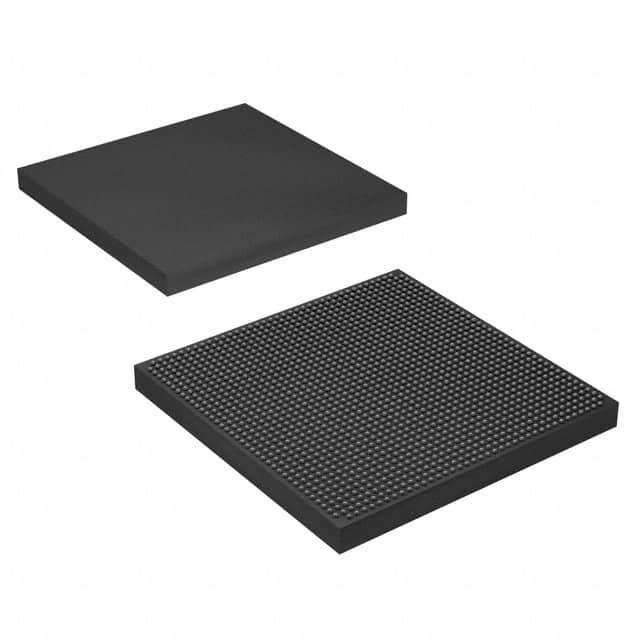Consulte las especificaciones para obtener detalles del producto.

5SGXEA7K2F40C3N
Product Overview
- Category: Integrated Circuit (IC)
- Use: Digital Signal Processing (DSP), High-performance Computing
- Characteristics: High-speed processing, Low power consumption
- Package: BGA (Ball Grid Array)
- Essence: Field Programmable Gate Array (FPGA)
- Packaging/Quantity: Single unit per package
Specifications
- Manufacturer: Intel Corporation
- Family: Stratix V
- Device: 5SGXEA7K2F40C3N
- Technology: 28nm
- Logic Elements: 462,000
- Embedded Memory: 27,648 Kbits
- DSP Blocks: 3,888
- I/O Pins: 1,280
- Operating Voltage: 1.0V
- Operating Temperature: -40°C to 100°C
Detailed Pin Configuration
The 5SGXEA7K2F40C3N FPGA has a complex pin configuration with 1,280 I/O pins. These pins are used for various purposes such as input, output, clock signals, and configuration. The detailed pin configuration can be found in the manufacturer's datasheet.
Functional Features
- High-speed processing: The 5SGXEA7K2F40C3N FPGA is designed to handle complex digital signal processing tasks at high speeds.
- Low power consumption: Despite its high performance, this FPGA consumes relatively low power, making it suitable for power-sensitive applications.
- Versatility: With a large number of logic elements, embedded memory, and DSP blocks, this FPGA offers flexibility in implementing various algorithms and functions.
- Configurability: Being a field-programmable device, the 5SGXEA7K2F40C3N can be reprogrammed to adapt to changing requirements or to fix bugs without the need for hardware changes.
Advantages and Disadvantages
Advantages
- High-performance computing capabilities
- Low power consumption
- Versatile and flexible design
- Field-programmable for easy updates and modifications
Disadvantages
- Relatively high cost compared to other ICs
- Requires expertise in FPGA programming and design
Working Principles
The 5SGXEA7K2F40C3N FPGA operates based on the principles of digital logic. It consists of a large number of configurable logic elements interconnected through programmable routing resources. These logic elements can be programmed to perform various functions, allowing the FPGA to implement complex algorithms and computations. The configuration of the FPGA is stored in non-volatile memory and can be modified as needed.
Detailed Application Field Plans
The 5SGXEA7K2F40C3N FPGA finds applications in various fields that require high-performance computing and digital signal processing capabilities. Some of the potential application areas include:
- Telecommunications: The FPGA can be used in base stations, network switches, and routers to handle high-speed data processing and protocol handling.
- Aerospace and Defense: It can be employed in radar systems, communication systems, and image processing applications.
- Medical Imaging: The FPGA can be utilized in medical imaging devices such as ultrasound machines and MRI scanners for real-time image processing and analysis.
- Video Processing: It can be used in video encoding/decoding, video surveillance systems, and video analytics.
- High-Frequency Trading: The FPGA's high-speed processing capabilities make it suitable for implementing algorithmic trading strategies in financial markets.
Detailed and Complete Alternative Models
- 5SGXEA7K2F40I3N: Similar to 5SGXEA7K2F40C3N, but with extended temperature range (-55°C to 125°C).
- 5SGXEA7K2F40C2N: Similar to 5SGXEA7K2F40C3N, but with a smaller package size.
- 5SGXEA7K2F40C4N: Similar to 5SGXEA7K2F40C3N, but with increased logic elements and DSP blocks.
These alternative models offer similar functionality with slight variations in specifications and features.
Word count: 515 words
Enumere 10 preguntas y respuestas comunes relacionadas con la aplicación de 5SGXEA7K2F40C3N en soluciones técnicas
Sure! Here are 10 common questions and answers related to the application of 5SGXEA7K2F40C3N in technical solutions:
Q: What is the 5SGXEA7K2F40C3N FPGA used for? A: The 5SGXEA7K2F40C3N is a Field-Programmable Gate Array (FPGA) that can be used for various applications such as high-performance computing, networking, and digital signal processing.
Q: What are the key features of the 5SGXEA7K2F40C3N FPGA? A: Some key features include a large number of logic elements, high-speed transceivers, embedded memory blocks, and support for various communication protocols.
Q: Can the 5SGXEA7K2F40C3N FPGA be used for real-time video processing? A: Yes, the FPGA's high-performance capabilities make it suitable for real-time video processing applications like video encoding, decoding, and image recognition.
Q: Is the 5SGXEA7K2F40C3N FPGA suitable for high-bandwidth networking applications? A: Absolutely, the FPGA's high-speed transceivers and support for communication protocols like Ethernet and PCIe make it well-suited for high-bandwidth networking solutions.
Q: Can the 5SGXEA7K2F40C3N FPGA be used for implementing cryptographic algorithms? A: Yes, the FPGA's flexible architecture allows for the implementation of various cryptographic algorithms, making it suitable for secure communication systems.
Q: Does the 5SGXEA7K2F40C3N FPGA support parallel processing? A: Yes, the FPGA's parallel processing capabilities enable the execution of multiple tasks simultaneously, making it ideal for applications that require high computational throughput.
Q: Can the 5SGXEA7K2F40C3N FPGA be used in industrial automation systems? A: Absolutely, the FPGA's ability to interface with different sensors and actuators makes it suitable for implementing control systems in industrial automation.
Q: Does the 5SGXEA7K2F40C3N FPGA support high-speed data acquisition? A: Yes, the FPGA's high-speed transceivers and embedded memory blocks allow for efficient data acquisition from various sources like ADCs or image sensors.
Q: Is the 5SGXEA7K2F40C3N FPGA suitable for implementing digital signal processing algorithms? A: Yes, the FPGA's high-performance capabilities and support for DSP libraries make it well-suited for implementing complex digital signal processing algorithms.
Q: Can the 5SGXEA7K2F40C3N FPGA be reprogrammed after deployment? A: Yes, being a Field-Programmable Gate Array, the 5SGXEA7K2F40C3N can be reprogrammed even after deployment, allowing for flexibility and adaptability in the system design.
Please note that the specific application and implementation details may vary depending on the requirements and design considerations of each project.

